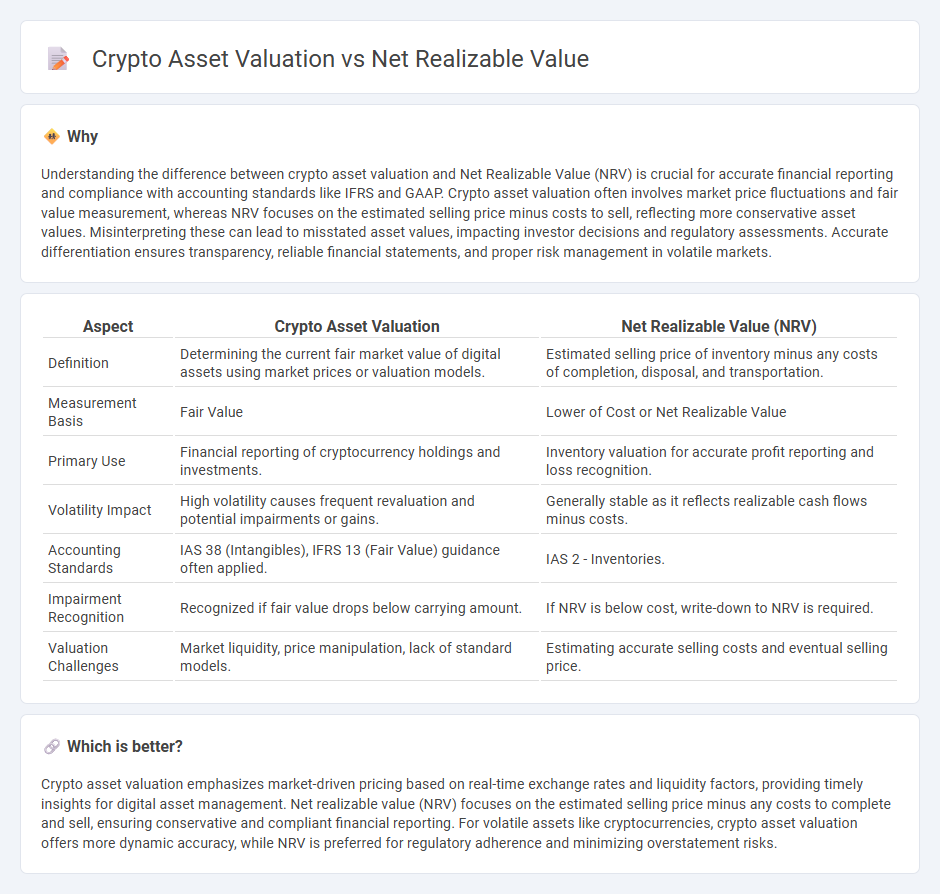
Crypto asset valuation requires specialized methods that account for market volatility, liquidity, and regulatory changes, differing significantly from traditional Net Realizable Value (NRV) approaches used in accounting. Unlike NRV, which estimates the net amount expected from asset sale less costs, crypto asset valuation integrates real-time market data and digital asset characteristics. Explore more to understand the key distinctions and implications for financial reporting.
Why it is important
Understanding the difference between crypto asset valuation and Net Realizable Value (NRV) is crucial for accurate financial reporting and compliance with accounting standards like IFRS and GAAP. Crypto asset valuation often involves market price fluctuations and fair value measurement, whereas NRV focuses on the estimated selling price minus costs to sell, reflecting more conservative asset values. Misinterpreting these can lead to misstated asset values, impacting investor decisions and regulatory assessments. Accurate differentiation ensures transparency, reliable financial statements, and proper risk management in volatile markets.
Comparison Table
| Aspect | Crypto Asset Valuation | Net Realizable Value (NRV) |
|---|---|---|
| Definition | Determining the current fair market value of digital assets using market prices or valuation models. | Estimated selling price of inventory minus any costs of completion, disposal, and transportation. |
| Measurement Basis | Fair Value | Lower of Cost or Net Realizable Value |
| Primary Use | Financial reporting of cryptocurrency holdings and investments. | Inventory valuation for accurate profit reporting and loss recognition. |
| Volatility Impact | High volatility causes frequent revaluation and potential impairments or gains. | Generally stable as it reflects realizable cash flows minus costs. |
| Accounting Standards | IAS 38 (Intangibles), IFRS 13 (Fair Value) guidance often applied. | IAS 2 - Inventories. |
| Impairment Recognition | Recognized if fair value drops below carrying amount. | If NRV is below cost, write-down to NRV is required. |
| Valuation Challenges | Market liquidity, price manipulation, lack of standard models. | Estimating accurate selling costs and eventual selling price. |
Which is better?
Crypto asset valuation emphasizes market-driven pricing based on real-time exchange rates and liquidity factors, providing timely insights for digital asset management. Net realizable value (NRV) focuses on the estimated selling price minus any costs to complete and sell, ensuring conservative and compliant financial reporting. For volatile assets like cryptocurrencies, crypto asset valuation offers more dynamic accuracy, while NRV is preferred for regulatory adherence and minimizing overstatement risks.
Connection
Crypto asset valuation relies on determining the fair market value of digital assets, which fluctuates based on market conditions and liquidity. Net realizable value (NRV) connects to this process by representing the estimated amount expected to be received from the sale of crypto assets, after deducting any costs related to selling. Both concepts intersect in accounting practices to ensure accurate financial reporting and compliance with valuation standards for volatile crypto holdings.
Key Terms
Fair value
Net realizable value (NRV) measures the estimated selling price of an asset minus any costs to complete and sell, often used in inventory and receivables valuation. Crypto asset valuation emphasizes fair value, reflecting the price that would be received to sell an asset in an orderly transaction between market participants at the measurement date, incorporating market demand, supply, and volatility. Explore more to understand how fair value accounting frameworks specifically impact crypto asset reporting and financial statement accuracy.
Impairment
Net realizable value (NRV) in crypto asset valuation reflects the estimated selling price minus costs of disposal, providing a conservative measure under impairment accounting. Impairment assessments require comparing an asset's carrying amount to its recoverable amount, often the NRV for crypto assets subject to volatile market prices. Explore how impairment testing influences crypto asset reporting and the implications for financial transparency.
Market price
Net realizable value (NRV) for crypto asset valuation depends heavily on the market price, reflecting the expected selling price minus any costs to sell. Market price volatility directly impacts NRV accuracy, requiring continuous updates to reflect real-time conditions. Explore advanced methods to optimize crypto asset valuation in fluctuating markets.
Source and External Links
How To Calculate a Net Realizable Value in 3 Steps | Indeed.com - Net realizable value (NRV) is the amount of cash a company expects to receive from the sale or disposal of an item after deducting any associated costs, calculated as expected selling price minus total production and selling costs.
Net Realizable Value (NRV) | Formula + Calculator - Wall Street Prep - NRV is the profit realized from selling an asset after estimated sale or disposal costs, calculated as expected sale price minus total sale or disposal costs, used for inventory valuation and impairment.
Net realizable value - Wikipedia - NRV is an accounting measure under GAAP and IFRS for inventory valuation, defined as the expected sales price less selling costs to prevent overstating asset values, with the valuation recorded at the lower of cost or NRV.
 dowidth.com
dowidth.com